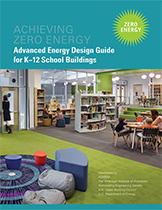 Achieving Zero Energy
Achieving Zero Energy
The Advanced Energy Design Guide—Achieving Zero Energy series provides a cost-effective approach to achieve advanced levels of energy savings. The four-color Guides offer contractors and designers the tools, including recommendations for practical products and off-the-shelf technology, needed for achieving a zero energy building which is defined as a building that, on an annual basis, draws from outside resources equal or less energy than it provides using on-site renewable energy sources. These Guides have been developed through the collaboration of ASHRAE, the American Institute of Architects (AIA), the Illuminating Engineering Society (IES), and the U.S. Green Building Council (USGBC), with support from the Department of Energy (DOE), to help meet all of an owner's energy performance requirements. In an effort to promote building energy efficiency, ASHRAE and its partners have made these Guides available for download (PDF) at no charge.
FREE DOWNLOAD
Print copies of the Guides are available for purchase in the ASHRAE Bookstore.
Interested in the 50% Guides? Learn More
For these categories of buildings
Multifamily Buildings:

For multifamily residential buildings, and applies primarily to construction of new multifamily buildings covered by ANSI/ASHRAE/IES Standard 90.1 up to twenty floors, although much of the guidance also applies to retrofits of existing buildings, depending on the depth and breadth of the retrofits. Space types covered include independent tenant living spaces with units ranging from one to three bedrooms, where each unit has a kitchen space, bathroom(s), bedroom(s), and living spaces; first-floor spaces such as common meeting spaces, a workout room, and staff/management offices or low-energy-density mixed-use spaces such as light retail and leased offices; vertical transportation; and laundry facilities. The Guide establishes a set of energy performance goals for achieving zero energy. The goals are provided for all ASHRAE climate zones, in both site and source energy. Strategies on how to achieve these energy targets are provided throughout the Guide.
Purchase print edition
Download free PDF edition
K-12 School Buildings:

For K-12 school buildings, and applies to all sizes and classifications (elementary, middle, high). Space types covered include administrative and office space, classrooms, hallways, restrooms, gymnasiums and multipurpose rooms, libraries, and food preparation and dining areas. The Guide establishes a set of energy performance goals for achieving zero energy. The goals are provided for all ASHRAE climate zones, in both site and source energy. Strategies on how to achieve these energy targets are provided throughout the Guide.
Purchase print edition
Download free PDF edition
Small to Medium Office Buildings:

For small to medium office buildings, and applies to office buildings ranging from roughly 10,000 to 100,000 ft2 with a building height of less than 75 ft. Space types covered by the Guide include office areas, circulation spaces, storage areas, break rooms (with a refrigerator, ice machine, dishwasher, microwave, sink, small appliances, and vending), small data centers/closets, workout rooms, and conference and meeting spaces. The Guide does not consider specialty spaces with extraordinary heat generation, large ventilation requirements, or pollution generation. The Guide establishes a set of energy performance goals for achieving zero energy. The goals are provided for all ASHRAE climate zones, in both site and source energy. Strategies on how to achieve these energy targets are provided throughout the Guide.
Purchase print edition
Download free PDF edition
Sponsoring Partners